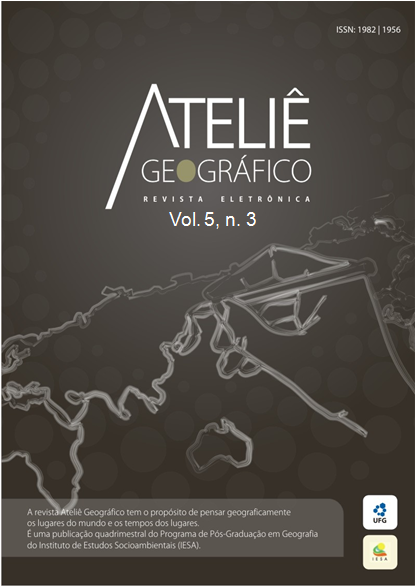THE SPECIAL OPERATING SUGARCANE PLANTATION GOIÁS: the case of the municipality of Inhumas
DOI:
https://doi.org/10.5216/ag.v5i3.16702Abstract
This article presents partial results from a survey entitled "City of Inhumas: with and without floor edge on the border of metropolises." The overall objective is to identify the social and environmental impacts of the advance of cane sugar in the state of Goias and, specifically, to understand the consequences of the advance of agribusiness on the fringe of the metropolis. The methodology used consisted at first in secondary data collection by the IBGE, SEPLAN, CEASA, RAIS, SEFAZ, EMBRAPA and in a second stage, conducting semi-structured interviews with cane cutters in the city, small landowners, Residents and traders in the region, to evaluate the impacts of the expansion of sugarcane in the region. The results indicated the environmental and social impacts of Inhumas municipality and region, associated with the monoculture of sugarcane, such as homogeneity in the production process, because the land use aims to produce large economic scale, the logic of the agribusiness of cane sugar has been generating social exclusion, for leases of land for planting sugarcane are expropriating the property of the small population, and thus pushing them to the city.
Downloads
Downloads
Published
How to Cite
Issue
Section
License
Autores que publicam nesta revista concordam com os seguintes termos:- Autores mantém os direitos autorais e concedem à revista o direito de primeira publicação, com o trabalho simultaneamente licenciado sob a Licença Creative Commons Attribution que permite o compartilhamento do trabalho com reconhecimento da autoria e publicação inicial nesta revista.
- Os autores não serão remunerados pela publicação de trabalhos na Revista Ateliê Geográfico. Além disso, os conteúdos publicados são de inteira e exclusiva responsabilidade de seus autores, ainda que reservado aos editores o direito de proceder a ajustes textuais e de adequação às normas da publicação.
- Autores têm permissão e são estimulados a divulgar seu trabalho online (ex.: em repositórios institucionais ou na sua página pessoal), já que isso pode gerar alterações produtivas, bem como aumentar o impacto e a citação do trabalho publicado (Veja O Efeito do Acesso Livre).


